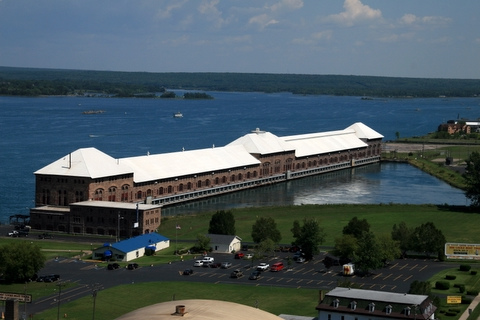Located at the northern tip of Michigan where Lake Superior, Lake Michigan, and Lake Huron join together, the Sault Ste. Marie Hydroelectric Power Complex was built to harness the hydroelectric potential of the 20-foot falls at the headwaters of the St. Marys (sic) River, the sole outlet of Lake Superior. A century after its construction, the plant remains the largest low-head hydroelectric facility in the United States. Today, the Sault Ste. Marie plant supplies electricity to area residents, especially those in the Upper Peninsula of Michigan.
In order to secure customers in a relatively remote region, the plant's developers signed long-term contracts to sell power at a low cost, thus requiring the construction of a large-scale plant. The need to create maximum output within economic and geographic constraints presented a multitude of practical problems, which were solved by an extensive staff of civil engineers, several of whom went on to celebrated careers in the profession.
Facts
- The plant's primary customer at the time of its construction was Union Carbide, a then-fledgling business that required a large amount of electric power to produce calcium carbide, an essential ingredient in making acetylene. Union Carbide eventually purchased the plant to supply its own industrial power.
- Half of the power plant's large feeder canal was dug through rock, but the other half passed through a mixture of sand and clay unable to withstand the force of the canal's water flow. Installing a timber lining -- completely submerged to help preserve it -- solved this problem. The timber lining remains intact today.
- The headhouse of the Sault Ste. Marie plant is more than a quarter-mile long and contains 80 turbine chambers, only 40 of which were used when the plant was opened. The 40 horizontal turbine mechanisms manufactured and installed in 1902 remain in place at the facility and in operation.
- The facility's power canal can feed water at 30,000 cubic feet per second -- a volume greater than most rivers -- qualifying it as the largest in the world.
- More than a dozen leading engineers served their apprenticeships on the Sault Ste. Marie hydroelectric project. Among them were Ralph Modjeski, designer of the Oakland Bay Bridge, and seven future officers of the American Society of Civil Engineers, including Alfred Noble, who served as president of ASCE in 1903, Clements Herschel, who served as president in 1916, and James W. Rickey, honored with the Society's Rickey medal.
- The Sault Ste. Marie plant was bought by the Edison Sault Electric Company in 1963 and shifted to the production of electricity for use in homes and offices.
Resources
- Terry S. Reynolds, "The Soo Hydro: A Case Study of the Influence of Managerial and Topographical Constraints on Engineering Design," IA: The Journal of the Society for Industrial Archeology , Volume 8
- Terry S. Reynolds, Sault Ste. Marie: A Project Report (Washington, DC: Historic American Engineering Record, 1982); gov. doc. no. I 29.74:Sa 8



